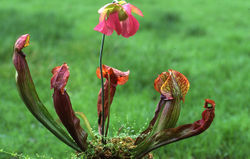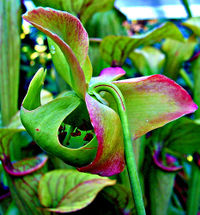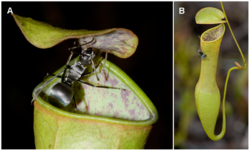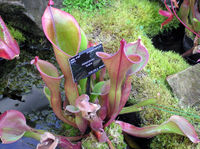Pitcher plant
| Pitcher plant |
|---|
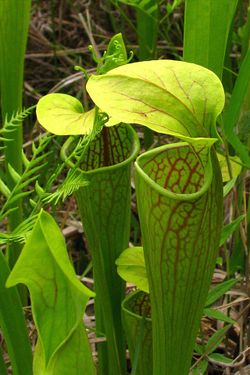
|
| Scientific Classification |
|
| Genera |
|
| Most pitcher plants possess a single large flower sitting atop a long photosynthetic stem. |
Pitcher plants and any of the species of carnivorous plants belonging to the taxonomic family Sarraceniaceae. They are found in bogs, marshes, and swamps across many regions of the earth, including India, North America, South America, Asia, Australia, and Africa. These carnivorous plants are especially noted for their large cup-like leaves used to drown prey in a pool of enzyme-filled water. These pitchers provide a home and a food source for several microscopic organisms as well. Pitcher plant extract (Sarapin) has been used medicinally for pain and digestive disorders.
Body Design
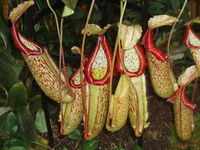
These monocot perennial plants are most noted for their open cauldrons, which are actually types of leaves. The "pitchers" generally grow from the end of tendrils or simply protrude from the ground directly.[3] These carnivorous organs range from a couple of centimeters to 1.5 meters deep.[4] Thick leaf veins help to support these conspicuous structures. Ranging in color from black to bright red and secreting an odorous waxy substance, these large leaves attract insects. The rim of the pitcher contains parallel rows of ridges and secretes slippery nectar to create a treacherous environment for visiting insects.[3] Some species of pitchers, such as Sarracenia oreophila, are known to produce an intoxicating substance that creates a decreased level of awareness for the prey. Many insects will slip into the pitcher, which contains a slurry of water and digestive juices inside. Downward-facing hairs keep the insect from struggling back upward. Effectively drowning its prey, the pitcher plant begins to digest the food alive.[5]
Many pitchers also display a wide lid-like leaf above the opening in order to keep out excessive rain or unwanted debris.[6] The flowers of the pitcher plant vary by species. However, most plants feature a large flower at the end of a long stem suspended above the pitcher leaves. Many of these flowers face downward with a cupped shape, acting as mini pitchers to catch pollen.[3] Underground, these plants possess roots that primarily serve to anchor the plant and absorb water. While most pitchers have a collection of roots, some have no roots at all, as their needs are supported by their carnivorous leaves, the environment, and others organisms.[7] The unspecialized leaves of the pitcher plant serve for photosynthesis.[8]
Life Cycle
When the pollen from a pitcher plant reaches the stigma of another, pollination and fertilization take place, beginning the development of embryonic pitcher plants in several seeds. After maturing, these seeds will be dispersed by the wind[3] similar to the way dandelions spread seeds. When the seeds meet moist soil, the plant will begin to germinate. Pitcher plants generally grow very slowly, taking several months to grow even a few centimeters.[7] With proper sunlight, the plant will continue to grow and develop their large pitchers from leaves, as long as the plant requires additional nutrients by means other than photosynthesis and root absorption. Within a number of months or even years, the pitchers will finally open and disperse their odorous nectar for insects or even small mammals.[8]
For years, the plant will provide its nitrogenous needs by decomposing insects, rats, or even birds in these pitchers. Because a single plant will generally produce more than one pitcher, damage to one leaf will not be fatal to the entire plant. Within upwards of ten years, many species may begin to shoot up climbing leaves that anchor to trees and provide additional support for the growing pitchers. As the plant fully matures and develops flowers, male and female gametes are produced. As wind carries pollen to other plants, the life cycle of a pitcher repeats itself. Approaching the end of the pitcher plant's life, it will dry out completely and begin to decompose, providing nutrients for additional pitcher plants and other organisms.[7]
Ecology
Pitcher plants are found widely throughout North America, South America, Asia, Australia, Africa, and India. They are commonly found in nutrient-poor soil with relatively high acidity.[9] Environments such as bogs, swamps, marshes, tropical forests, and various other ecosystems are common for these plants.[10] Depending on geographic location, the pitcher plant may prey on a wide variety of insects and small animals. As an odorous scent attracts these creatures, many feed upon the pitcher's rim or inside surface. Coating the surface is a greasy substance that encourages additional consumption, and provides a more slippery environment for the prey.[11] As the creature eventually falls into the pool of liquid at the bottom, bacterial colonies provide the enzymes necessary for digestion. These bacteria live within the pitcher, and are generally specific to certain species of pitcher plant.[12] Also within this liquid live mites, protozoans, and rotifers, which consume some of the nutrients provided by decaying prey. Additionally, the pitcher is home to mosquito larvae, which carry on early development inside this solution. Many of these tiny organisms are not readily affected by the digestive enzymes produced the plant. This relationship is a form of commensalism, as these creatures obtain nutrients and also break down the larger pieces of prey into manageable sizes, more easily absorbed by the plant. Many of these decomposer organisms actually are not in competition with one another, as each one absorbs nutrients from the prey at different stages of decomposition.[13] However, the mosquito larvae often prey upon the smaller protists and bacterial communities[12] as well, essentially creating an entire food chain within each pitcher.[13]
One group of pitcher plants, however, obtains most of its nutrients from a type of tree shrew, Tupaia montana. Though the pitcher plant does not digest the mammal itself, the shrew will defecate into the pitcher as it feeds on the carbohydrate-rich tissue on the pitcher lid's lower surface. The feces provide a good source of nitrogen and minerals for the plant.[9] Again, this shows a commensalist relationship. Some research has actually suggested that the lid above the pitcher acts to provide protection for insects during rain, where rain drops vibrate the lid and shake insects directly below into the pitcher.[11] Though few animals have been observed eating the leaves of this plant, a few species of deer and wolves have been seen devouring these leaves during times of scarce food.[14] It has been reported that Native American tribes used the pitcher plant as a remedy for back pain, chills, whooping cough, smallpox, and various other ailments.[10]
Modern Use
Due to their exotic appeal and interesting skill set, many individuals grow pitcher plants in personal gardens. Emphasis is placed on recreating their natural environment. Thus, an abundance of light, high soil moisture, high humidity, and nutrient-low, acidic soil is encouraged.[15] Although pitcher plants can grow in nutrient-rich soil, the specialized pitcher leaves only develop in poor soil.[16] Gardeners also prize the flowers of the plant for their unique structure and smell.[15] Many botanical scientists studying these plants grow their own pitcher plants in order to more easily observe their interactions and to manipulate the environment for further study.[17]
Pitcher plant extracts are used in modern medication for digestive disorders, constipation, pain, urinary tract diseases, and to prevent scar formation. This natural product has been approved by the FDA for treating these disorders.[18] The extract, known as Sarapin, is generally taken by injection.[19] Because this medication is not widely used, not much research has been done into the side effects or appropriate dosage. Reported side effects include feelings of intense heat or sensations of abnormal heaviness.[18]
Gallery
References
- ↑ Sarracenia California pitcherplant. Web. Accessed 13 May 2014.
- ↑ Brittnacher, John. Phylogeny and biogeography of the Sarraceniaceae Carnivorous-Plants. Web. Published Semptember 2013.
- ↑ 3.0 3.1 3.2 3.3 Chen, Jason. Nepenthes Encyclopedia of Life. Web. Accessed 12 May 2014.
- ↑ Patrick. GiantPitcherPlant ThinkTwiceRelaunched. Web. Published 13 August 2009.
- ↑ Sarracenia ICPS. Web. Accessed 13 May 2014.
- ↑ AboutCarnivorousPitcherPlants LearnAboutNature. Web. Accessed 12 May 2014.
- ↑ 7.0 7.1 7.2 Murray, Ann. Life-Cycle-of-a-pitcher-plant eHow. Web. Accessed 11 May 2014.
- ↑ 8.0 8.1 Ginsburg, Elisabeth. PitcherLifeCycle GardenGuides. Web. Accessed 13 May 2014.
- ↑ 9.0 9.1 Fessenden, Marissa. Small Mammal Pitcher Plant Toilet MongaBay.com. Web. Published 8 November 2011.
- ↑ 10.0 10.1 Smith, Paul. Adirondack Wildflowers Paul-Smith's-College. Web. Accessed 26 May 2014.
- ↑ 11.0 11.1 Uses Rain drops to capture prey ScienceDaily. Web. Published 13 June 2012.
- ↑ 12.0 12.1 Pitchers Harbor Diverse Bacteria PMC. Web. Published 22 January 2010.
- ↑ 13.0 13.1 Lycaon.Pitcher Bacterial Microcosm The-Olive-Tree. Web. Published 2 June 2011.
- ↑ Northern Pitcher Plant Wetland-Wildflowers-of-Illinois. Web. Accessed 26 May 2014.
- ↑ 15.0 15.1 Roberson, Kelly. PitcherPlantBasics Better-Homes-and-Gardens. Web. Accessed 26 May 2014.
- ↑ Szesze, Michael. CarnivorousPlants Carnivorous-Plant-Nursery. Web. Accessed 26 May 2014.
- ↑ Rice, Barry. Pitcher Leaves The-International-Carnivorous-Plant-Society. Web. Revised January 2007.
- ↑ 18.0 18.1 Pitcher Plant WebMD. Web. Accessed 26 May 2014.
- ↑ Sarapin HealthWays. Web. Accessed 26 May 2014.
